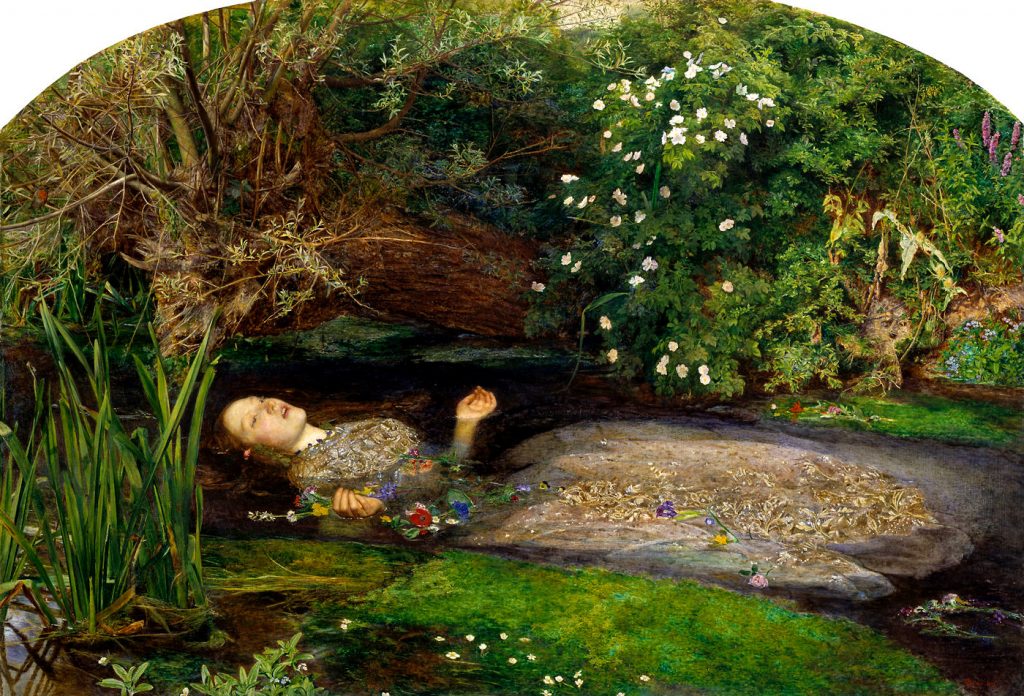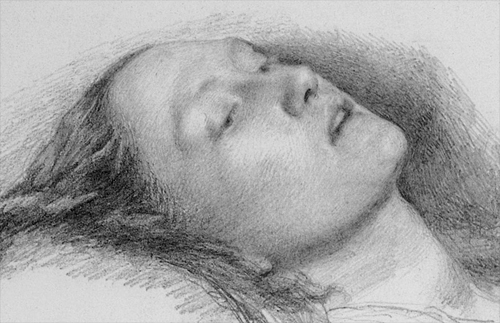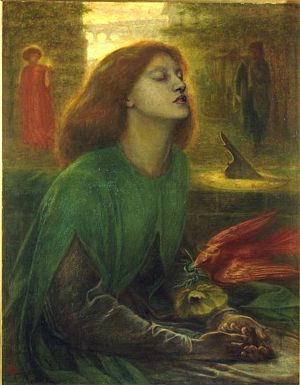The scene where Queen Gertrude describes Ophelia’s death in Hamlet is one of the most poignant moments in Shakespeare’s play.
When John Everett Millais painted Ophelia he chose to depict her in the moments just before she drowns.
Ophelia is a shining example of the Pre-Raphaelite artist’s desire to depict truth in nature. In the midst of this picture of death, the plant life is rich and colorful. Each plant, whether in background or foreground, is given equal attention and no detail is spared.
The botanical aspects of Ophelia are so important that Millais chose to labor over the background long before adding in the figure of Ophelia.
Prior to the action of the play, Hamlet and Ophelia are in love. After seeing his father’s ghost, Hamlet decides to distance himself from her as he plots revenge for his father’s murder.
When Hamlet kills Ophelia’s father, Polonius, she loses her sanity. Even though she appears quite mad, the flowers she gives to the King, Queen and Laertes have pointed meanings that would have been obvious to Shakespeare’s audience.
Ophelia: “There’s rosemary, that’s for remembrance; pray you, love, remember: and there is pansies, that’s for thoughts.”
Laertes: “A document in madness,–thought and remembrance fitted.”
Ophelia: “There’s fennel for you, and columbines:–there’s rue for you; and here’s some for me:–we may call it herb-grace o’Sundays:–O you must wear your rue with a difference.–There’s a daisy:–I would give you some violets, but they wither’d all when my father died:–they say he made a good end. ” [Sings] “For bonny sweet Robin is all my joy–“
The scene contains no stage direction, but it is generally accepted that Ophelia hands the flowers out.
To her brother Laertes, rosemary and pansies. For remembrance and thought, both of which are probably alluding to their slain father.
To King Claudius, fennel and columbines. Fennel for flattery. Columbine may mean ingratitude. Fennel was also believed to cast away evil spirits. Perhaps Ophelia was suggesting that Claudius was evil.
To Queen Gertrude, rue and daisy. Rue for repentance. Is the queen to wear hers with a difference because she shows no repentance for her previous husband’s death? Daisy for faithlessness. See Ophelia’s End: Does She Hand Out the Flowers?
In addition to the flowers mentioned in Hamlet, Millais added other flowers with symbolic meaning. Forget-me-nots are visible on the bank. A red poppy floats near Ophelia’s hand, a symbol of sleep and death. Despite her saying that there were no violets, we can see she wears a necklace of them. Fritillary, symbols of sorrow, also appear.
In Act 4, Scene 5 we hear Queen Gertrude’s description of Ophelia’s death. Again, plants play an important role.
QUEEN GERTRUDE: There is a willow grows aslant a brook,
That shows his hoar leaves in the glassy stream;
There with fantastic garlands did she come
Of crow-flowers, nettles, daisies, and long purples
That liberal shepherds give a grosser name,
But our cold maids do dead men’s fingers call them:
There, on the pendent boughs her coronet weeds
Clambering to hang, an envious sliver broke;
When down her weedy trophies and herself
Fell in the weeping brook. Her clothes spread wide;
And, mermaid-like, awhile they bore her up:
Which time she chanted snatches of old tunes;
As one incapable of her own distress,
Or like a creature native and indued
Unto that element: but long it could not be
Till that her garments, heavy with their drink,
Pull’d the poor wretch from her melodious lay
To muddy death.
And so Ophelia dies a watery death, alone with her flowers. Gertrude describes her as mermaid like in an attempt to beautify the ugliness of death.
Millais used Elizabeth Siddal as the model for Ophelia. You can read more about her uncomfortable experience posing for the painting on the Ophelia page of my site LizzieSiddal.com.
Millais set up a series of oil lamps under a bathtub in order to keep the water she posed in a comfortable temperature. The lamps did not last, however, and Siddal posed for hours in the cold, never saying a word.
This led to illness and the threat of a lawsuit from her father. Siddal later married fellow Pre-Raphaelite artist Dante Gabriel Rossetti; she died of a laudanum overdose two years after their marriage.
It is a macabre coincidence that a poppy floats so close to Siddal’s hand in Ophelia. After her death, Rossetti painted Beata Beatrix as a posthumous tribute, where a dove delivers a poppy (from which opium is derived) into her hand.
Laudanum is a mixture of opiates and alcohol.
“… pray you, love, remember…”




2 thoughts on “Ophelia’s Flowers”